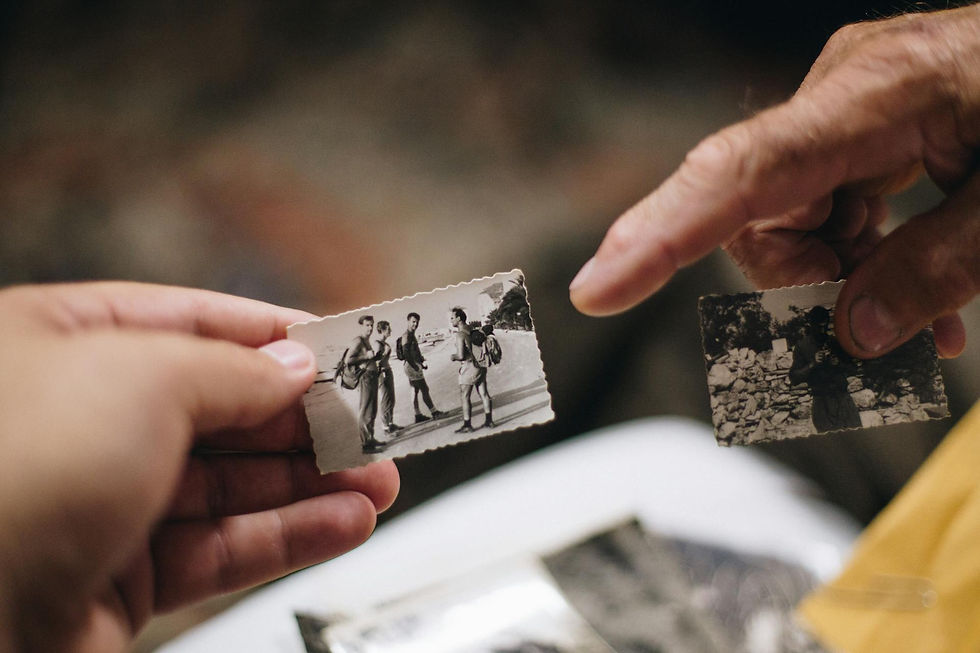Rediscovering Roots and Preserving Heritage
- Isabelle Karamooz

- Jul 6
- 6 min read
In a constantly changing world, reconnecting with our roots has never been more essential. Heritage — in all its tangible and intangible forms — is not merely about preserving old objects or dusty archives. It is about safeguarding our cultural identity, honoring the lives and sacrifices of our ancestors, and better understanding who we are in a complex and globalized society.
As Stéphane Bern, renowned French TV presenter and heritage advocate, points out:“Heritage is not a luxury, it is a necessity. It is the living memory of our societies, a link between past, present, and future generations. Protecting our heritage is protecting our identity.”

Understanding why our ancestors left their homeland sheds light not only on personal stories but also on the socio-economic and political forces that shaped major waves of migration. These stories reveal human resilience and adaptability, painting a nuanced picture of history that textbooks alone cannot provide.

Part I: Understanding the Forces Behind Emigration — A Historical Perspective
To fully grasp our ancestors’ journeys, it is crucial to place their decisions within the broader historical, economic, and social contexts that influenced migratory movements. Emigration never happens in a vacuum; it is a complex response to multiple pressures.
Economic Pressures and Crises
The late 19th and early 20th centuries were particularly turbulent for many rural and industrial European communities. The phylloxera epidemic, starting around 1863, devastated vineyards in southwestern France, wiping out many families’ livelihoods. Simultaneously, the industrial crisis in northern France’s textile mills caused widespread unemployment and economic instability.
For many, these economic hardships became unbearable, pushing them to leave in large numbers. Some sought work in the Argentine vineyards, applying their agricultural skills, while others moved to Pennsylvania’s coal mines, drawn by growing industrial demand.
Historian Jean-Luc Pinol reminds us:“Economic crisis is not just data or numbers; it is a lived experience, a rupture of familiar markers that pushes people to exile—sometimes in hope of a better life, sometimes out of absolute necessity.”
Political Turmoil and National Identity
Political upheavals also deeply impacted migration decisions. The Franco-Prussian War of 1870 led to the annexation of Alsace-Lorraine by the new German Empire. This change forced many residents to confront questions of nationality and loyalty. Some refused German citizenship and chose to emigrate to countries like Canada or the United States, hoping to preserve their cultural and linguistic ties with France.
Additionally, the anti-clerical laws of the French Third Republic (1880–1905) led to the persecution of certain religious minorities, especially Protestants in the Cévennes and other groups who found the political climate oppressive. This religious repression fueled new departures, notably to more tolerant regions such as Louisiana and French-speaking Canada.
As Claire Barbillon, researcher in migration sociology, explains:“Questions of national and religious identity often lie at the heart of emigration decisions. It’s not just a flight but an act of seeking belonging, dignity, and freedom.”

Social and Demographic Factors
Social structures also played a crucial role. In regions where primogeniture prevailed, younger siblings had little chance of inheriting family land, forcing them to seek opportunities elsewhere. Overpopulation in rural provinces such as Brittany intensified competition for scarce resources.
Young men and women were attracted by the promise of cheap land and a fresh start in regions like Oregon or Manitoba. The Homestead Act in the United States, offering free land to settlers, became a major draw for many European migrants seeking economic independence.
Part II: Methodologies to Trace Family History and Preserve Memory
The journey to rediscover your family origins and preserve heritage is as rewarding as it is complex. Success requires a systematic approach to gathering and interpreting diverse sources.
Collecting Oral Histories: The Foundation of Memory
The cornerstone of genealogical research often lies in oral memory. Speaking with elders—grandparents, great-aunts, cousins—provides insights that no archive can match. Using the “three circles” technique—asking questions about home, work, and celebrations—helps unlock rich and detailed memories.
Recording these interviews ensures their preservation and allows multiple family members to benefit.
These stories provide essential context for interpreting official documents and filling gaps left by records alone.
As professional genealogist Françoise Drouet explains:“Stories told by elders are the key to understanding not only what they lived through but why certain decisions were made. Every detail matters and deserves to be preserved.”
Exploring Official and Digital Archives
The guide Preserving Heritage: A Guide to Finding Sources and Resources is an indispensable companion for research enthusiasts. It outlines key repositories:
Departmental archives in France provide civil status records, cadastral plans, and censuses.
National archives in the U.S., such as those at Ellis Island, document immigrant arrivals and naturalizations.
Notarial archives reveal contracts, wills, and property transactions, essential for understanding family wealth and movements.
Online platforms such as Ancestry, FamilySearch, and Filaé facilitate cross-border and cross-generational research.
Including military archives adds a valuable layer, revealing enlistments and service that often influenced migration decisions.

Using Historical Newspapers and Journals
Newspapers are treasure troves of social and economic information. Digital collections like Gallica in France or Chronicling America in the U.S. allow access to local newspapers, obituaries, and public notices. They help place family stories within broader events—for example, understanding the impact of a factory closure or a local agricultural failure.
DNA and Digital Humanities: New Frontiers
Technological advances are reinventing genealogy.
Autosomal DNA tests help identify unknown cousins and verify family trees.
Mitochondrial DNA testing offers deep insight into the maternal line, sometimes tracing back thousands of years.
Digital humanities tools like Neatline (for mapping migrations) or Transkribus (for automatic document transcription) greatly facilitate data analysis.
This scientific dimension enriches traditional research and opens new paths.

Part III: Case Study – The Duval Family: A Micro-History of Migration
To illustrate these approaches, consider the example of the Duval family, originally from Creuse, who emigrated to Wisconsin.
The family mostly consisted of younger sons who couldn’t inherit land, facing economic hardship linked to the phylloxera crisis and harsh winters.
The Ferry laws of 1882, which made education free but imposed French on dialect speakers, deepened feelings of cultural exclusion.
The family departed from Saint-Nazaire in 1883, arrived at Castle Garden in New York, then settled in Brown County, Wisconsin, benefiting from the Homestead Act.
Archival evidence includes family letters referencing fertile black soil and federal censuses from 1900, supported by DNA matches with cousins remaining in France.
This micro-history illustrates how intertwined economic, political, and social pressures triggered emigration, while demonstrating concrete methods to document these movements.


Part IV: The Art and Science of Preservation: From Documents to Buildings
Heritage preservation goes beyond archives to include physical structures and collective memory.
Principles of Archival Conservation
Conservation begins with appropriate preventive care: storage in acid-free materials, environmental control, and high-resolution digitization.
In cases of damage, curative methods—such as professional restoration of moldy or fragile documents—ensure collection longevity.
Sharing through online exhibitions, printed albums, or family podcasts encourages transmission and community engagement.
Preserving Family Homes and Monuments
France’s Ministry of Culture oversees thousands of protected sites, including 9 national parks, 163 reserves, and 100,000 hectares of protected coastline. Their approach—using authentic materials and sustainable techniques—serves as a model for restoring ancestral homes.
Owners are encouraged to prioritize traditional stone, brick, and wood, while adopting modern biosourced insulation. These efforts honor craftsmanship and reduce environmental impact.
Part V: Why Preservation and Historical Research Matter in 2025
At a time when the world is increasingly mobile and interconnected, understanding one’s heritage offers essential benefits:
Identity and belonging: knowing your roots anchors your sense of belonging amid constant change.
Informed citizenship: mastering migration stories fosters empathy and inclusion.
Sustainability: restoring and reusing buildings and documents aligns with ecological responsibility.
Cultural continuity: passing down stories and traditions ensures survival of diverse histories in collective memory.

Conclusion: Weaving Past, Present, and Future
Heritage preservation and genealogical exploration are not acts of nostalgia but acts of hope and continuity. They transform fragments of the past into a compass for future generations.
Open the attic chest, question your elders, dive into archives, test your DNA—through these gestures, you will discover not only why your ancestors left their homeland but how their hopes still resonate in your life today.
Call to Action
Share your discoveries on social media with hashtags #FQMHéritage and #FamilyRoots. Your story enriches the great tapestry of human migrations and cultural preservation.
Header Photo Credit: Max Fischer: https://www.pexels.com/photo/a-two-girls-using-laptop-with-classmates-5212695/











Comments